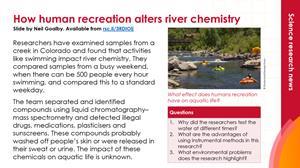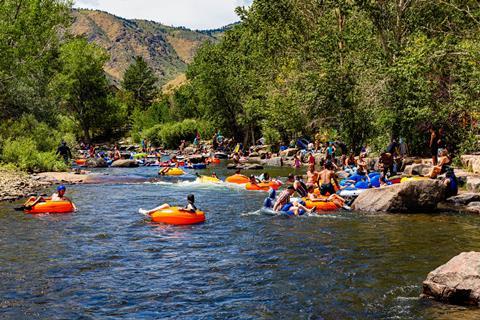Explore how swimming and tubing has been linked to concerning rises in water contaminants
-

Download this
Use this story and the accompanying summary slide to give your 14–16 learners real-world context when studying water or analysis using instrumental techniques.
Download the story as MS Word or PDF and the summary slide as MS PowerPoint or PDF.
Human activities such as tubing and swimming significantly impact river chemistry, suggests preliminary research. The US team behind this work were observing contaminants present in the water at Clear Creek in Colorado. On summer weekends, this river is a popular tourist spot with up to 500 people tubing and swimming in it per hour.
The scientists collected water samples during a busy US public holiday in September 2022 and on a quiet weekday afterwards. Back in the lab, they conducted analysis to determine differences in the organic and metal contaminant concentrations between the samples collected on these two days. The team used instruments including an inductively coupled plasma mass spectrometer and a liquid chromatography-high resolution mass spectrometer to separate out, identify and determine concentrations of the contaminants.

A chemical cocktail
The team found elevated levels of many organic and metal contaminants in the samples from the busy day. The organic contaminants include cocaine and pharmaceuticals such as antihistamines and anti-seizure medications. The scientists say these likely came from sweat and urine. The scientists also detected ingredients from organic sunscreens and personal care products that they assumed washed off the skin. Metals detected included copper, lead, zinc, aluminium and iron. The scientists attributed these to visitors stirring up river sediment, causing the metals to be released back into the water.
‘For a large majority of these compounds, we don’t have data on their chronic aquatic toxicity,’ explained Noor Hamdan, a PhD student at Johns Hopkins University, while discussing this research at a meeting of the American Chemical Society in August. ‘We don’t have data on their persistence and their mobility in the environment,’ she continued.
Further work is needed to confirm that humans really are significantly impacting the creek’s chemistry and to understand the environmental implications of the study’s findings. The team plan to use statistical analysis to improve their understanding of the changes occurring in the creek due to human presence. More samples were collected this September and, ultimately, the scientists would like to collect a longer series of samples to track trends over time.
Put this in context
Explore the role of analytical chemists at Thames Water in this job profile.
This article is adapted from Rebecca Trager’s in Chemistry World.
Nina Notman
References
Hamdan N et al, 2023, Assessing the impact of recreational activities on stream-water chemistry: a Colorado case study, ACS Fall Meeting: Harnessing the power of data! San Francisco, CA
Download this
Summary slide with questions and the article for context when teaching your 14–16 classes on water or analysis using instrumental techniques: rsc.li/3RDIOlj
Downloads
EiC summary slide Recreation alters river chemistry
Presentation | PowerPoint, Size 2.53 mbEiC summary slide Recreation alters river chemistry
Presentation | PDF, Size 0.36 mbEiC science research story Recreation alters river chemistry
Handout | PDF, Size 0.33 mbEiC science research story Recreation alters river chemistry
Handout | Word, Size 0.75 mb














No comments yet